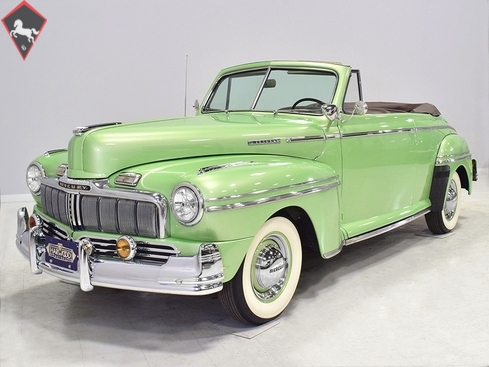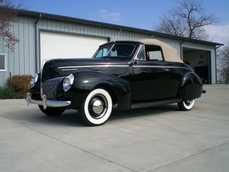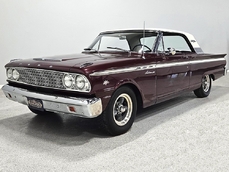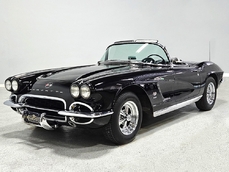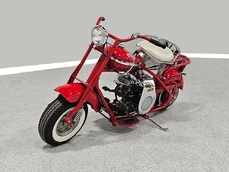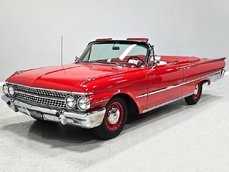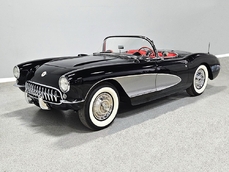Mercury Deluxe 239 cubic inch flathead V8 1947
General description :
It’s a mistake to think of Mercury as simply a re-badged Ford, and from its debut in 1939 to the day this handsome 1947 Mercury convertible coupe was built, they occupied a spot in the line-up more akin to an Oldsmobile or Buick. A bit bigger, a bit more horsepower, a bit more chrome, and a bit more sophistication all make choosing a Mercury over a Ford an easy decision. This particular Merc has been nicely restored with a few upgrades that make it a fantastic cruiser and very easy to live with, and none of those changes erase the genuinely fun road manners that you get with a flathead V8. This isn’t a car for the purist, but I can’t say that it doesn’t appeal to me in a big way simply because it asks for so little and delivers so much. Come try it on and you’ll see what I mean.
That bright green paint wasn’t on the color chart for 1947, but it doesn’t look wrong on the curvy Mercury bodywork, either. There’s a hint of metallic in the final finish and it just glows out in the sunlight, making this car impossible to miss. Underneath, however, none of the factory bodywork was altered, all the original chrome and stainless trim was retained, and it still looks like a car from 1947 is supposed to look. Although it looks very much like the post-war Fords, the Mercury sits on a 4-inch longer wheelbase and none of the body panels are interchangeable—in the flesh, the Merc looks quite a bit more substantial. The familial resemblance is undeniable, but Mercurys received that unique “electric shaver” grille, extra stainless trim on the fenders, and unique emblems and badging that mean it can be recognized at a glance. During the comprehensive restoration, all that brightwork was restored, including the bumpers, which feature rare (and very expensive) bumper ends that really dress the car up nicely. Other accessories include fog lights, a spotlight on the driver’s A-pillar, and a set of aftermarket blue dot headlights that light up the road like flamethrowers at night. Workmanship is quite good, with straight bodywork, good fit and finish, and an overall feeling that the car is well-assembled and durable, which is surely how it felt when it was new.
The two-tone interior was freshened using soft leather instead of the original vinyl, and it makes a difference from the moment you slide behind the wheel. The handsome seat covers were custom made to match the original look and there’s new padding underneath so it’s comfortable for long drives. Matching door panels in the original style were created at the same time and there are fresh carpets and mats on the floor, all bound to look like they were born there. The dash was obviously repainted to match the bodywork and retains its original plastic moldings and original gauges, all of which are operational. The electrical system has been converted to 12 volts so things like the wipers and radio have been updated in the interest of making driving a bit safer and more interesting, and we like that they worked hard to retain things like the accessory under-dash heater. Overhead there’s a beautifully made canvas convertible top, and it folds easily with a touch of a knob under the dash then stashes under a matching vinyl boot. The trunk is trimmed to match the interior, with new bulkheads and carpets, as well as a matching full-sized spare tire that’s never been used and a remote CD changer. Nice!
Mercurys received the same bulletproof 239 cubic inch flathead V8 used in other post-war Fords, and there’s really no better choice for fun in an old car. This one has been fully rebuilt using a stock bottom end and a few period performance upgrades, including Offenhauser aluminum heads and a matching intake with twin Stromberg 97s on top. The 12-volt electrical system means an electronic ignition system is part of the deal, as well as a big chrome alternator on top that looks like a vintage generator. There’s fresh wiring, a new fuel system with an electric fuel pump and regulator system, and a big radiator fed by twin polished stainless inlet tubes. Hit the starter button and the well-tuned flatty barks to life easily and idles with a bubbly idle that suggests the Merc wants to go out and play. There’s plenty of horsepower on tap, and the experience isn’t all that far removed from a stock flathead, making this convertible feel suitably vintage without being a sitting duck in traffic. It’ll cruise happily at 60 MPH all day and makes all kinds of great sounds while it’s doing it.
Underneath, the chassis and floors are in excellent condition with no signs that it was ever a rusty car. The stock 3-speed manual has a fresh clutch that doesn’t have the usual flathead chatter, even in reverse, and the original rear end features 3.55 gears for decent cruising under all conditions. The suspension is completely stock, right down to the correct gaiters on the transverse leaf springs and stock drum brakes all around are plenty effective for the car’s performance. Dual exhaust with Smitty mufflers sounds like it’s 1954 all over again and it has the kind of springy, eager handling that makes all flathead Fords (and Mercurys!) a delight to drive. The floors are in great shape with nothing to hide, the lines and hoses were all replaced during the restoration, and there’s a new gas tank hanging out back. Factory 16-inch wheels carry Mercury hubcaps and trim rings, as well as correct 6.70-15 BFGoodrich Silvertown wide whitewall tires.
This Merc also includes a LOT of extras, including a set of restored fender skirts that are ready to install, a complete set of books and manuals, wiring diagrams, parts lists, and a lot of spare parts such as trim pieces, the original radio, mechanical fuel pump, gauges, original air cleaner, hubcaps, a spare transmission, the original intake manifold and generator, and much more!
I remain convinced that Ford flatheads remain the single best all-around hobby car you can own. They’re affordable, they’re fun, they’re competent, parts are plentiful, and all their “problems” have been ironed out over the last 70 years. They feel and drive like old cars, which is the point after all, but they don’t feel archaic. This Mercury is a much rarer piece than most and the fact that it’s been upgraded to look like it might have in the 1950s is a great piece of nostalgia that changes nothing about the car’s charm. Get in and go, the fun is standard equipment. Call today!
http://www.harwoodmotors.com/vehicles/inventory_details.php?id=1061
1947 Mercury Deluxe 239 cubic inch flathead V8 is listed sold on ClassicDigest in Macedonia by for $36900.
Car Facts
Car type : Car Make : Mercury Model : Deluxe Model Version : 239 cubic inch flathead V8 Engine size : 0.0 Model Year : 1947 Sub type : Convertible Location : Ohio
Sold
Seller Information
Sold
People who viewed this Mercury Deluxe also viewed similar Mercury listed at ClassicDigest
Other cars listed for sale by this dealer
About Mercury
Mercury, the automotive brand, has a rich history that extends beyond its role in the customization and hot-rodding scene, particularly with the iconic Mercury Eight. Here are some key points to know about Mercury:Formation and Early Years:
Mercury was introduced by the Ford Motor Company in 1938 as a mid-priced brand, positioned between the affordable Ford models and the luxury Lincoln lineup. The brand aimed to fill the gap between these two segments.
Mercury Eight:
The Mercury Eight, launched in 1939, is perhaps the most famous model in the brand's history. It featured a sleek design and a powerful V8 engine. This model became popular for customization and hot-rodding, earning it a significant place in American automotive culture.
Customization Culture:
The Mercury Eight, with its distinctive styling and relatively affordable price, became a favorite among custom car builders. It played a pivotal role in the development of the custom car and hot rod culture, particularly in the post-World War II era.
Lead Sleds and Customization:
The term "lead sled" is often associated with heavily customized cars from the 1940s and 1950s. These cars, including the Mercury Eight, were often modified with lowered suspensions, chopped roofs, and other stylistic changes. Lead sleds were a prominent part of the custom car scene, and the Mercury Eight was a popular choice for such modifications.
Post-War Prosperity:
In the post-World War II period, Mercury, like many other American automakers, experienced a surge in popularity as the economy boomed. The brand contributed to the era's fascination with stylish and powerful automobiles.
Evolution of Models:
Over the years, Mercury continued to produce various models, contributing to Ford's lineup. Some notable models include the Mercury Monterey, Mercury Comet, and Mercury Cougar.
Decline and Discontinuation:
Despite periods of success, Mercury faced challenges in establishing a unique identity separate from Ford. As consumer preferences shifted, the brand struggled, and Ford eventually announced the discontinuation of Mercury in 2010.
Legacy in Popular Culture:
Mercury, especially models like the Mercury Eight, holds a significant place in American popular culture. Its association with the customization and hot-rodding scene, as well as its distinctive designs, has left a lasting impact.
In summary, while the Mercury Eight is celebrated for its role in the customization and hot-rodding subculture, Mercury as a brand played a broader role in automotive history, contributing to mid-priced segments and reflecting the automotive trends of its time.
